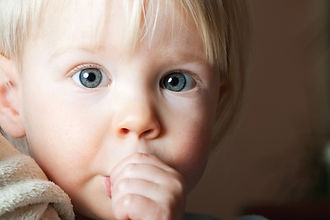

1. Reflexive Schemes: Birth- 1 month
Newborn Reflexes: Reflexes are an inborn, automatic response to a particular form of stimulation
-Moro: Flinging arms wide and brining back towards the body (startle)
-Rooting reflex: Turning head towards breast to help with breastfeeding
-Sucking
-Blinking
-Withdrawal
-Babinski reflex: Occurs after the sole of the foot has been firmly stroked. The big toe then moves upward or toward the top surface of the foot. The other toes fan out.
-Palmer Grasp: Fingers squeeze against the palm, instead of against themselves as in the raking grasp
-Crawling
-Stepping
-Escape
The video to the left provides an example of the moro reflex.
(Berk, 2013, p. 82-83)
2. Primary Circular Reactions: 1-4 months
Simple motor habits centered around the infant's own body; limited anticipation of events. In this stage infants will repeat chance behaviors largely motivated by basic needs. One example of this would be babies to begin to suck their thumbs.
(Berk, 2013, p. 119)

3. Secondary Circular Reactions: 4-8 months
Actions aimed at repeating interesting effects in the surrounding world. imitation of familiar behavior.
The video to the left provides an example of a child doing this (pressing the button to get music)
(Berk, 2013, p. 119)
Piaget:
Sensorimotor Stage
4. Coordination of Secondary Circular Reactions: 8-12 monts
Intentional, or goal-directed behavior; ability to find a hidden object in the first location in which it is hidden (object permanence); improved anticipation of events, imitation of behaviors slightly different from those the infant usually performs.
The video to the left shows a child who understands object permanence.
(Berk, 2013, p. 119)
5. Tertiary Circular Reactions: 12-18 months
Exploration of the properties of objects by acting on them in novel ways; imitation of novel behaviors; ability to search in several locations for a hidden object (accurate A-B search).
The video to the left shows a child who is unable to successfully complete the A-B search. I believe showing this video gives a better idea of the growth that a child has than if I had shown a video of a child who could successfully complete the task. Sometimes knowing what was done wrong helps to appreciate when it's done correctly.
(Berk, 2013, p. 119)
6. Mental Representation: 18 months-2 years
Internal depictions of objects and events, as indicated by sudden solutions to problems; ability to find an object that ha been moved while out of sight (invisible displacement); deferred imitation and make-believe play.
The video to the left shows two brothers engaging in make-believe play
(Berk, 2013, p. 119)
Infancy & Toddlerhood
